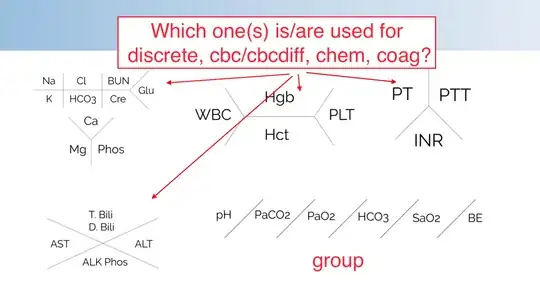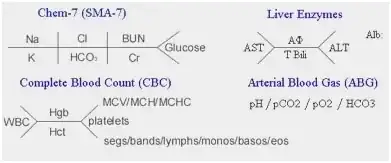Which lab value skeleton diagrams are used for discrete, cbc/cbcdiff, chem, and coag results?
- 5,814
- 1
- 17
- 39
- 121
- 1
- 2
-
https://medicalsciences.stackexchange.com/help/on-topic – JMP Nov 06 '18 at 02:37
-
@JonMarkPerry If you take a look at this meta discussion you'll see that the focus here has changed and some things like the help section still need to be updated. This question is a bit obscure and could use some editing, but it's not off topic. – Carey Gregory Nov 06 '18 at 05:13
-
1That said, to the OP, could you please spell out your question a bit more in plain language? You're talking to a wide audience. – Carey Gregory Nov 06 '18 at 05:40
-
@CareyGregory; which meta discussion? - your link just points to the meta site! – JMP Nov 06 '18 at 07:51
-
1@JonMarkPerry - Take a look at https://medicalsciences.meta.stackexchange.com/a/962 – Chris Rogers Nov 06 '18 at 08:09
-
@ChrisRogers; I still think this is a question for Biology.SE. It's not a question I would expect my GP to answer. – JMP Nov 06 '18 at 08:17
-
1@JonMarkPerry But its a question you would expect a medical student / a clinician to know, and this is the site for them. It’s not a site so that you can ask your GP, but a site where medical professionals share knowledge. Yes, that means we overlap with human biology, naturally – Narusan Nov 06 '18 at 14:01
-
@Narusan; okay, but doesn't 'overlap' mean 'is the same'? how does 'medical sciences' differ from 'biology'. and this would have been discussed during the original site formation process. probably not a question for here though. – JMP Nov 06 '18 at 14:45
-
@JonMarkPerry I think you need to spend some time browsing the meta section and see the transformation that has been taking place. It's a beta site, and as such it's still evolving. – Carey Gregory Nov 06 '18 at 15:08
-
@CareyGregory; it's just that several questions exactly like this one have already been closed. i'll read the meta over the week. – JMP Nov 06 '18 at 16:10
-
@JonMarkPerry I think questions that have been closed or migrated because they belong in Biology usually don't have much medical relevance. There's a lot of overlap but they're not the same. – Carey Gregory Nov 06 '18 at 16:14
-
@CareyGregory; like Stack Overflow vs. Super User? – JMP Nov 06 '18 at 16:44
-
@JonMarkPerry Yeah, that's not a bad analogy. SciMed is basically applied biology just as SuperUser is applied software. – Carey Gregory Nov 06 '18 at 18:47
-
@CareyGregory; then this question isn't really applied Biology in the sense that the Health proposal put forward. https://area51.stackexchange.com/proposals/66048?phase=definition – JMP Nov 06 '18 at 19:51
-
A clinician or student would know what the skeletons are by the abbreviation, so OP is likely either early in their studies or not in the field. But it's a simple enough answer, and people may be interested in seeing how it's used, so I answered it. – DoctorWhom Nov 07 '18 at 01:00
1 Answers
These skeleton diagrams are used as short hand to avoid having to write units and test names for lab values - you can just look at a diagram of numbers and know what they apply to. Sodium is always in the same place, as is K, Cl, etc.
The skeletons are as follows:
Na K Cl HCO3 BUN Cr Glu = Chemistry 7
if you add AST ALT Alk Phos TBili Prot Ca = Chemistry 14 (which are usually in vertical form).
- Your diagram has just the LFTs, which can be represented as in your diagram, or in others (it varies).
PT PTT INR = coagulation panel
pH PaCO2 PaO2 HCO3 SaO2 BE = ABG (Arterial Blood Gas)
WBC Hgb Hct Plt = key components of CBC (Complete Blood Count) without diff.
I found this example of writing the CBC diff, but have never actually seen it written out like that.
Per request, this is a Khan academy video on lab values. I couldn't find any formal resources on fishbone diagrams, they're kind of passed on in medical education...
- 5,814
- 1
- 17
- 39
-
1Might be useful to mention that you'll see a few different shorthand diagrams for LFTs, but I've never seen a different way to diagram a CBC or chem 7 – De Novo Nov 07 '18 at 01:08
-
Are there any reputable references you can provide for background reading to what you have provided here? – Chris Rogers Nov 07 '18 at 08:41
-
That's tough because most of this is just passed down, but I found a video from Khan academy – DoctorWhom Nov 09 '18 at 14:40

